-
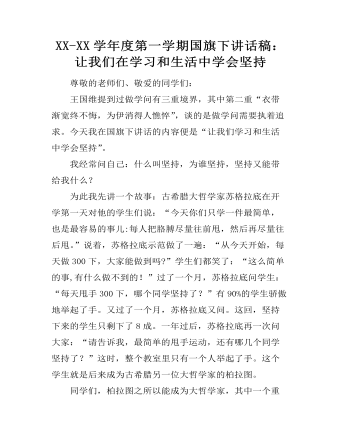
XX-XX学年度第一学期国旗下讲话稿:让我们在学习和生活中学会坚持
尊敬的老师们、敬爱的同学们:王国维提到过做学问有三重境界,其中第二重“衣带渐宽终不悔,为伊消得人憔悴”,谈的是做学问需要执着追求。今天我在国旗下讲话的内容便是“让我们学习和生活中学会坚持”。我经常问自己:什么叫坚持,为谁坚持,坚持又能带给我什么?为此我先讲一个故事:古希腊大哲学家苏格拉底在开学第一天对他的学生们说:“今天你们只学一件最简单,也是最容易的事儿:每人把胳膊尽量往前甩,然后再尽量往后甩。”说着,苏格拉底示范做了一遍:“从今天开始,每天做300下,大家能做到吗?”学生们都笑了:“这么简单的事,有什么做不到的!”过了一个月,苏格拉底问学生:“每天甩手300下,哪个同学坚持了?”有90%的学生骄傲地举起了手。又过了一个月,苏格拉底又问。这回,坚持下来的学生只剩下了8成。一年过后,苏格拉底再一次问大家:“请告诉我,最简单的甩手运动,还有哪几个同学坚持了?”这时,整个教室里只有一个人举起了手。这个学生就是后来成为古希腊另一位大哲学家的柏拉图。
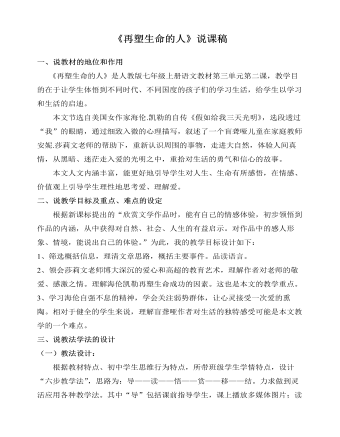
部编版语文七年级上册《再塑生命的人》说课稿
一、说教材的地位和作用《再塑生命的人》是人教版七年级上册语文教材第三单元第二课,教学目的在于让学生体悟到不同时代、不同国度的孩子们的学习生活,给学生以学习和生活的启迪。 本文节选自美国女作家海伦.凯勒的自传《假如给我三天光明》,选段透过“我”的眼睛,通过细致入微的心理描写,叙述了一个盲聋哑儿童在家庭教师安妮.莎莉文老师的帮助下,重新认识周围的事物,走进大自然,体验人间真情,从黑暗、迷茫走入爱的光明之中,重拾对生活的勇气和信心的故事。本文人文内涵丰富,能更好地引导学生对人生、生命有所感悟,在情感、价值观上引导学生理性地思考爱、理解爱。二、说教学目标及重点、难点的设定根据新课标提出的“欣赏文学作品时,能有自己的情感体验,初步领悟到作品的内涵,从中获得对自然、社会、人生的有益启示。对作品中的感人形象、情境,能说出自己的体验。”为此,我的教学目标设计如下:
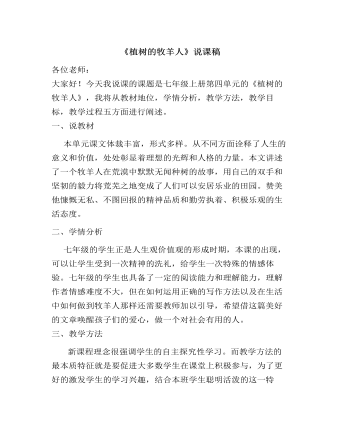
部编版语文七年级上册《植树的牧羊人》说课稿
各位老师:大家好!今天我说课的课题是七年级上册第四单元的《植树的牧羊人》,我将从教材地位,学情分析,教学方法,教学目标,教学过程五方面进行阐述。一、说教材本单元课文体裁丰富,形式多样。从不同方面诠释了人生的意义和价值,处处彰显着理想的光辉和人格的力量。本文讲述了一个牧羊人在荒漠中默默无闻种树的故事,用自己的双手和坚韧的毅力将荒芜之地变成了人们可以安居乐业的田园。赞美他慷慨无私、不图回报的精神品质和勤劳执着、积极乐观的生活态度。二、学情分析七年级的学生正是人生观价值观的形成时期,本课的出现,可以让学生受到一次精神的洗礼,给学生一次特殊的情感体验。七年级的学生也具备了一定的阅读能力和理解能力,理解作者情感难度不大,但在如何运用正确的写作方法以及在生活中如何做到牧羊人那样还需要教师加以引导,希望借这篇美好的文章唤醒孩子们的爱心,做一个对社会有用的人。
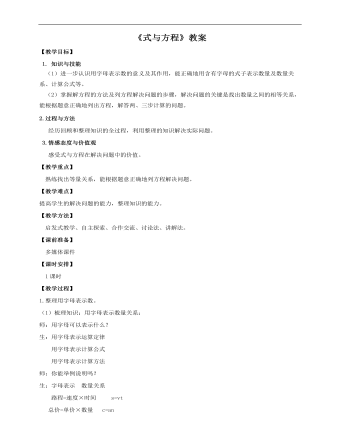
小学数学人教版六年级下册《第三课式与方程》教案说课稿
1.整理用字母表示数。(1)梳理知识:用字母表示数量关系:师:用字母可以表示什么?生:用字母表示运算定律用字母表示计算公式用字母表示计算方法师:你能举例说明吗?生:字母表示 数量关系路程=速度×时间 s=vt总价=单价×数量 c=an工作总量=工作效率×工作时间 c=at(2)字母表示计算方法:+=(3)用字母表示计算公式。师:用字母可以表示哪些平面图形的计算公式生:长方形 周长 c=(a+b) ×2 面积:s=ab 正方形 周长 c=4a 面积:s=a2 平行四边形 面积 s =ah三角形 面积 s=ah¸2 梯形 面积 s=(a+b)·h¸2 圆 周长c=πd=2πr 面积 s=πr2(4)用字母表示运算定律加法交换律 a+b=b+a 加法结合律 (a+b)+c=a+(b+c)乘法交换律 a×b=b×a乘法结合律 (a×b)×c=a×(b×c)乘法分配律 (a+b)×c=a×c+b×c2.在一个含有字母的式子里,数与字母、字母与字母相乘,书写时应注意的问题。师:在一个含有字母的式子里,数与字母、字母与字母相乘,书写时应注意什么?生交流:(1)在含有字母的式子里,数和字母中间的乘号可以用“?”代替,也可以省略不写。(2)省略乘号时,应当把数写在字母的前面。(3)数与数之间的乘号不能省略。加号、减号、除号都不能省略。3. 典题训练(1)填一填。①李奶奶家本月用电a千瓦时,比上个月多用10千瓦时,上个月用电( )千瓦时。②如果每千瓦时电的价格是c元,李奶奶家本月的电费是( )元。李奶奶家银行缴费卡上原有215元,扣除本月电费后,还剩( )元。③小明今年m 岁,妈妈的岁数比她的3倍少6岁。妈妈的岁数是( )岁。如果m=12,妈妈今年是( )岁。④三个连续的自然数,最大的一个是n,那么最小的一个数是( )。(2)连 一 连。比a多3的数 a3比a少3的数 3a3个a相加的和 a+33个a相乘的积 a-3a的3倍 a的

部编人教版四年级下册《 千年梦圆在今朝》教案
一、创设情境,导入新课。1.学生交流“神舟五号”有关资料,【出示课件2】“神舟五号”发射与飞行过程的录像。2.这节课让我们走进课文追寻奋斗者的足迹,让我们走进课文去探求去思考。(板书课题:8千年梦圆在今朝)请同学们读读课文前面的阅读提示,看看阅读提示给我们提出了哪些阅读建议。【出示课件3】默读课文,为什么千年的飞天梦能在今朝实现?二、初读课文,整体感知。(一)初读,解决字词。1.读课文,用自己喜欢的方式认识生字词语,扫除字词障碍。2.出示词语。
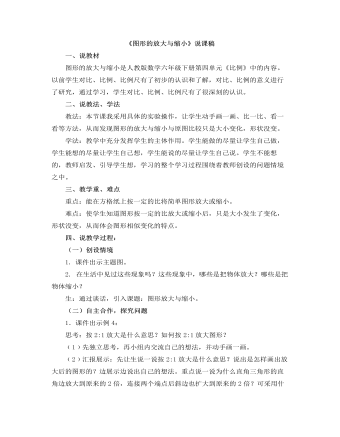
小学数学人教版六年级下册《图形的放大与缩小》说课稿
一、说教材图形的放大与缩小是人教版数学六年级下册第四单元《比例》中的内容。以前学生对比、比例、比例尺有了初步的认识和了解,对比、比例的意义进行了研究,通过学习,学生对比、比例、比例尺有了很深刻的认识。二、说教法、学法教法:本节课我采用具体的实验操作,让学生动手画一画、比一比、看一看等方法,从而发现图形的放大与缩小与原图比较只是大小变化,形状没变。学法:教学中充分发挥学生的主体作用。学生能做的尽量让学生自己做,学生能想的尽量让学生自己想,学生能说的尽量让学生自己说。学生不能想的,教师启发、引导学生想,学习的整个学习过程围绕着教师创设的问题情境之中。 三、教学重、难点重点:能在方格纸上按一定的比将简单图形放大或缩小。难点:使学生知道图形按一定的比放大或缩小后,只是大小发生了变化,形状没变,从而体会图形相似变化的特点。
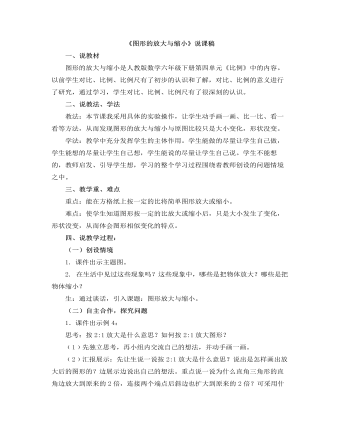
小学数学人教版六年级下册《图形的放大与缩小》说课稿
一、说教材图形的放大与缩小是人教版数学六年级下册第四单元《比例》中的内容。以前学生对比、比例、比例尺有了初步的认识和了解,对比、比例的意义进行了研究,通过学习,学生对比、比例、比例尺有了很深刻的认识。二、说教法、学法教法:本节课我采用具体的实验操作,让学生动手画一画、比一比、看一看等方法,从而发现图形的放大与缩小与原图比较只是大小变化,形状没变。学法:教学中充分发挥学生的主体作用。学生能做的尽量让学生自己做,学生能想的尽量让学生自己想,学生能说的尽量让学生自己说。学生不能想的,教师启发、引导学生想,学习的整个学习过程围绕着教师创设的问题情境之中。 三、教学重、难点重点:能在方格纸上按一定的比将简单图形放大或缩小。难点:使学生知道图形按一定的比放大或缩小后,只是大小发生了变化,形状没变,从而体会图形相似变化的特点。

人教版新目标初中英语七年级下册What does he look like教案3篇
所需要用到的句子:Who is that?That is Jack. I like him.Why do you like him?I like him because he is interesting.Task 4: 设计理想中的人类Step one: 设计理想中的人类的外貌。把全班同学分成若干小组,学生可以边说边在纸上画出他们的模样。Step two: 设计理想中人类的性格。学生们可以把那些能描述性格的单词写在图画的旁边。Step three: 每组选出一名同学,其他同组同学提问,他作简单回答,并说明原因。所需用到的句子:What does he or she look like?He or she ...What is he or she like?He or she is ...Why?Because ...Task 5: 挑战性活动调查性格是天生的还是后天形成的,让每个同学回家去调查一下自己成长过程中性格是否有变化,具体是怎样的,为什么会这样? Teaching Aims:1. Enable students to have a general understanding of how to talk about people's physical appearance.2. Enable students to tackle some essential vocabularies and patterns about describing people. Provide them with necessary skills and methods.3. Create various chances for students to describe the persons they're familiar with, such as classmates, family members, teachers, idols, etc.

人教版新目标初中英语七年级下册Don’t eat in class教案2篇
Don’t fight. =You can’t fight. (板书,教读)教师把这些句子板书在黑板上,并请学生大声整齐地读祈使句和“can’t”句型,并让学生注意两种句型表达形式的不同和转换,“Don’t …=You can’t…”;并对学生说:These are our school rules. (板书,教读) You can’t break the school rules. Don’t break the school rules.(板书,教读)步骤3 :Practicea. T: Now, each of the students is breaking one of these rules.Please finish 1a.学生看图,完成1a的内容,检查答案并大声朗读校规。b. 听录音,完成1b,选出四位学生都违反了哪条校规;听之前,学生要读会英文名。c. 请两位学生朗读1c部分的句型;要求学生两人一组对话表演,SA扮演外校转来新生,SB告知本校校规。(学生可经过讨论,多说出他们想到的校规,不必只限于书上;教师应给予帮助)2) 第二课时(2a~4)步骤1 :warming up of revisionT: What are the rules at your school?学生使用“can”或祈使句表达各条校规;其中老师可引出“eat in the cafeteria outside”的表达。步骤2 :Practicea.T: Christina is an exchange student. She doesn’t know the rules. Let’s listen, what activities they’re talking about?学生听第一遍时,完成2a;第二遍时,完成2b;b. 请学生领读2c部分,看着2a完成的表格,理解2c活动的要求;分成小组针对2a进行问答;

人教版新目标初中英语七年级下册I ’d like some noodles教案
教学过程Step 1: warming-up Sing a song---------“food and drink” Step 2: Revision1 Dictation2 Revise: What kind of noodles would you like?I’d like …What size bowl of noodles would you like?I’d like…Step 3: Presentation1 show pictures of food, ask students say the words.2 Students read the newspaper ad in 3a. Fill in blanks with words in the box. Then read the ad together, the teacher explains some difficult language points.3 Check the answers Step 4 PracticeAsk students to finish 3b in the same way according to 3a. Students read the short passage and fill in the blanks .At last, check the answers.Step 5 productionAsk students to write their own ad for dumplings, noodles, drinks, and other foods they know. Then ask students to read their partner’s ad. Then order food and drink from their partner.Step 6 Home workGroup work – make an ad about “food and drink”

人教版新目标初中英语七年级下册I want to be an actor教案2篇
三、教学建议第一课时:1. Lead in (Vocabulary)A) Before class, teacher should collect some pictures of working places. For example: Bank, TV Station, Restaurant, Police Station, Hospital ...B) In class, show students the pictures (PowerPoint, OHP). Ask students to tell the name of the working places and the name of the jobs.Shop assistant, doctor, actor, reporter, police office, waiter, bank clerk, studentC) Do exercise 1a and 3a.2. Bingo GameAsk groups of students to make up pairs of cards with a job on one and the related workplace on the other. For example, waiter / restaurant, teacher / school, doctor / hospital. Encourage students to use both the job / workplace combinations in the book and the ones that students came up during class discussions. Be sure they have twice as many sets of cards as there are students in the group. They can make two sets of cards for a single job / workplace, if necessary. Then have each group mix up its set of cards and hand their cards out in random order. Each time a student gets a pair of cards that match, he or she can lay these cards down. The goal is to have no cards in your hand at the end.3. Task OneA) Ask students to work in pairs and ask the partner what does he / she want to be in the future.e. g. :What do you / does he / does she want to be?I want to be a.Why?Because it's (adj).B) Vocabulary: Section B, 1a4. Homework 1.2.

人教版新目标初中英语七年级下册It’s raining教案2篇
1 Each group choose one place to describe and what you are doing in it Choose one place, and describe what they are doing 2 Move around the room and give suggestions Talk about it and write it down 3 Ask one to show their works and act it Choose one of each group to make a report 4 Evaluate the best group and the best reporter Choose the best one Homework Ask your friends their ideal place and write about it教学反思:新课程标准中强调学生在课堂中的主体地位,在综合课中他们的主体地位就更加突出。在各个活动中给不同程度的学生不同层次的任务,让各层面的学生都有表现发挥的机会,从而产生对英语的兴趣。使用照片图片多媒体来辅助教学,效果更好。同时让了解其他国家风景,风俗的同学介绍ideal place,增加学生的背景知知识,实现跨学科交流的目的。教案点评:采用任务型教学模式,在各个活动中给不同程度的学生不同层次的任务,让各层面的学生都有表现发挥的机会,从而产生对英语的兴趣。使用照片图片多媒体来辅助教学,效果更好。让了解其他国家风景,风俗的同学介绍ideal place,增加学生的背景知识,实现跨学科交流的目的。

人教版新目标初中英语七年级下册Where is your pen pal from教案
2.1Match the country with the language.Step II Reading3a? let the students read the letter fast and answer the questions.? Let the students ask more questions about the letter as possible as the can.Step III Writing3b.Step IV. Pairwork2cStep V Listening2a, 2bStep V. HomeworkExercises book(1) P3Exercises book (2) P3Period FourStep I . Dictate the words and sentences in Unit1.Step II. Self-checkStep III. Check the answers for Exercises book in the unit.Step IV. Home workRevise and preparation for unit 2.教学反思:通过本单元的学习,学生基本可以谈论人们的国籍,居住城市及其所说的语言,通过书信方式去介绍自己并寻找笔友。但在涉及到国外的一些城市时,学生对这方面的知识相对欠缺,能介绍的城市并不多,也反应出学生课前预习不充分,这跟学生学习条件也有关,大多数学生无法通过网络获取所需信息。因此,在以后的教学中要多指导学生通过计算机网络获取信息,拓宽知识面。

人教版新目标初中英语七年级下册What do you think of game shows教案
五、教学Section B-2c1. Pair work: What do you think of the belt/sunglasses/…? What does your father/mother/… think of your scarf/belt…?2. Group work(1). Teacher shows some different kinds of school uniforms (制服)and asks : “ What do you think of your school uniforms? If you have a chance to choose your school uniforms, what kind would you like to choose?”(2). Discuss in groups.(3).Get some Ss to report in class.说明:这一步旨在让学生运用已有的语言知识谈论对事物的看法和意见,并简单阐明理由,培养学生的主动思维能力和运用英语的能力。六、教学拓展调查电视节目的收视率任务:调查你周围的人对现在各种电视节目的反响。活动过程:1.教师布置任务,让学生调查周围的人(包括他的亲戚朋友和邻居)喜欢收看哪方面的电视节目。2.学生进行调查活动,运用本单元所学的句型What do you think of….? (Why?)What's your favorite game shows?What do you think of talk show?I doesn’t mind it.I like it.I love it.I can’t stand it.3.记录下排在前10位的TV Program,填写调查表,比较其收视率。

人教版新目标初中英语七年级下册Where did you go on vacation教案
句型: Where did you go on vacation? I went to summer camp.Did she go to Central Park?Yes,she did.No, she didn’t语法:一般过去时特殊疑问句、一般疑问句及肯、否定回答。课时安排4课时第一课时:Section A:la,1b,lc,2a,2b,2c 第二课时:Section A:3a,3b,4第三课时:Section B:1,2a,2b,2c第四课时:Section B:3a,3b,3c,4 and Self Check第一课时教学目标掌握描写假期生活的形容词。假期里自己所做事情的简单表达。谈论假期做的事情及当时情况。谈论假期时旅游的天气,旅游者以及食物等。教学过程一、导入播放一首英文歌曲:Let’s travel 说明:通过让学生听节奏欢快迪斯尼英语歌曲Let’s travel.引入本节课谈论的话题vacation and travel. 让歌曲使学生的思维活跃,增强课堂气氛,激发学生提高学习英语的兴趣。T:How is the trip ?Ss : It’s pretty good/ happy/exciting /relaxing/busy/dangerous/ fantastic说明:这个问题是为了操练形容词。建议让多个Ss作答。鼓励他们用不同的形容词。上述个别形容词本应在第二课时中出现,但可以在warming-up中第一次非正式出现。这些形容词也可在老师的评价语中适时出现,以加深学生对词汇的印象。

人教版新目标初中英语八年级下册Have you ever been to an amusement park教案
(1)Have you ever been to …? Yes, I have. / Yes, I have ever been to …No, I haven’t. / No, I have never been to …(2)When did you go there? I went there last year. (3)I have never been to a water park. Neither have I. I have ever been to an amusement park. So have I. (4)How long have you been studying English? I’ve been studying English since nine o’clock. I’ve been studying English since I came back home. I’ve been studying English for five hours. (5)What’s that? It’s an amusement park in Japan. I’ve never been to an amusement park like it before. It’s fun to learn another language. Let’s go tonight. Isn’t this great?space museum, amusement park, water park, South America, Peru, Holland, European culture, tour guide, flight attendant, musical instrument, more than, be from, get to, take lessons, neither, discover, graduate, change

人教版新目标初中英语八年级下册What should I do教案2篇
说明:在帮Li Lei提建议的同时,教育学生如何学好英语。第三课时教学目标1. 语言目标:a) 词汇: Original, in style, haircut, the same as.b) 语言结构:My friend wears the same clothes and has the same haircut as I do.2. 能力目标:大多数学生能够谈论自己喜欢哪种服装,提高查找信息的能力。3. 情感目标:学会如何与朋友相处,要有自己对时尚的看法。教学重点掌握一些重要词汇。教学难点学会谈论问题,并能提出书面建议。◆教学突破首先针对Erin的问题,提出个人的建议,模仿2c部分的对话展开双人交际Pair-work;听老师诵读3a部分的信件,并找出LEFT OUT的问题所在;学生完成3b部分的内容,给Left Out提出书面的建议;学以口头形式提出自己目前存在的某个问题,讲给大家听,让同学们给自己提出一个建议,并作笔录;学生两、三个人分成一组,随意性地进行口语交际,谈论P14的第4部分的某个问题,相互交换意见。

人教版新目标初中英语八年级下册If you go to the party, you’ll have a great time教案2篇
区分宾语从句、定于从句和状语从句宾语从句和状语从句,都叫做主从复合句。宾语从句主要是中考必考的,是初中阶段必掌握的从句,宾语从句主要是掌握三要素,所谓宾语从句,就是宾语在主从复合句当中充当宾语的一个句子,叫做宾语从句。主句的谓语动词是及物动词,后面如果是词或者是短语的话,是简单句,如果是句子的话,肯定是宾语从句。I know that he good at English.就是宾语从句,三要素,一要素是要注意连词,连词一共学了三类连词,一类连词是that口语当中可以省略,就像刚才说的那一句,I hear he is good at English.还有疑问代词、疑问副词,how where when,疑问代词、疑问副词。还有一类连词weather是否的意思,不是状语从句当中的如果,这一定要和如果区分开,这是是否。I don't know if he interested at English。宾语从句要注意if是连词。第二要素是语序,要用陈述举语序。比如说你家有几口人,我们都说How many people are there in you family?但是这是简单句,一旦说成宾语从句,你可以告诉我你家有几口人吗?Could you tell me how many people there are in you family ?

人教版新目标初中英语八年级下册He said I was hard-working教案2篇
This activity introduces some new vocabulary and provide oral practice using the target language.Task 1 . Ask four students to stand in front of the class, and the teacher asks them the following questions as a reporter.1.What are you going to do when you grow up?2.What are you going to do next week?3.What are going to do after school?The students will give different answers, then ask a good student to report what they said.I am going to e a doctor.What did she say?----------She said she was going to be a doctor.I am going to have a party on Friday night.What did he say?-------He said he was going to have a party on Friday night.I am going to do my homework.What did she say ?------ She said she was going to do her homework.I am going home after school.What did she say?-----She said she was going home after school.Say In this unit we are going to learn to use words like to report what someone said.Task 2. Read the instructions. Then ask a student to read the four questions. And write the words on the Bb. Explain what soap opera is.Task 3. Ask the students to Look at the pictures, point out the TV screens in the picture. Ask one girl to read what Marcia said.What did Marcia say? She said She said she was having a surprise party for Lana on Friday night. Repeat the other pictures in the same way.Activity3. Listen and number the pictures in activity 1a.

人教版新目标初中英语八年级下册How long have you been collecting shells教案2篇
Step Ⅱ Show the new words on the screen and teach the new words. Read the new words to students and ask them to repeat.Step Ⅲ 3aThis activity introduces new vocabulary and provides reading practice using the target language.In this activity first look at the four pictures.T: What can you see in the pictures?Ss: Four snow globes.T: Right. There are four snow globes in the pictures. And what are they?Ss: They are a monster, two polar bears, two penguins and a birthday cake.Write these words on the blackboard: snow globe; monster; polar bear; penguin and birthday cake. Read them to the class and ask students to repeat each one. Make sure students understand each word.Use a computer to show the E-mail message on the screen and read the message to students.Get students to read the e-mail on their own, and then draw lines connecting each snow globe and its description.Correct the answers.AnswersA line should connect each snow globe picture with the words that describe it in the letter.Step Ⅳ 3bThis activity provides writing practice using the target language.First review Activity 2a on Page 47.Then ask students to complete the message according to Activity 2a.Some partial sentences are given to students. Write about one person's collection.When students work, walk around the room checking the progress and offering help as needed.When they finish, ask some students to read their messages to the class.